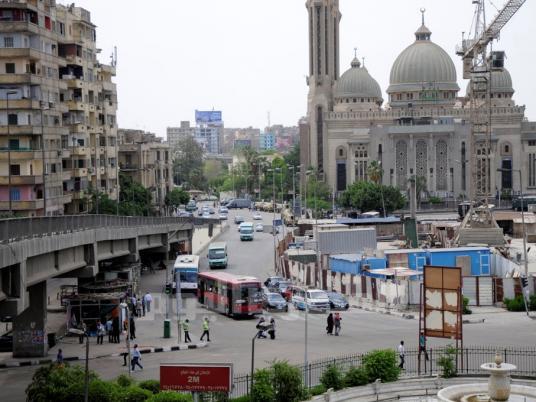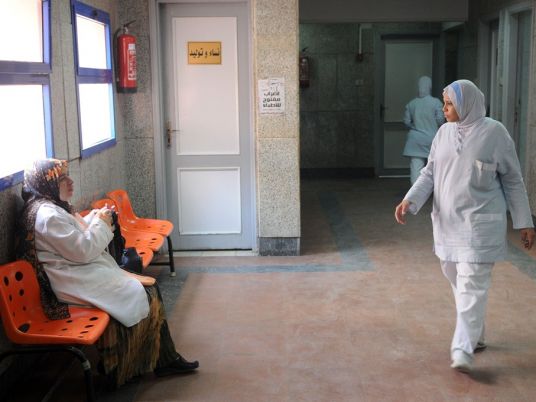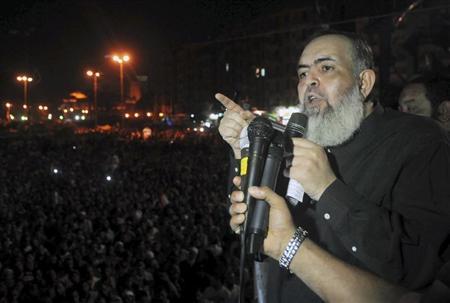
Two days after the military drove protesters from their sit-in in front of the Defense Ministry, Mostafa Hashem surveys the damage from the previous week’s clashes. The front window of his gas station is destroyed, save a single shard of glass clinging to the frame. Scorch marks and gaping holes dot the now-useless pumps.
“They were insisting on making a fire here,” Hashem says, as he recalls bearded men briefly setting the station alight two Saturdays ago. “But we don’t know who is for Hazem Salah and who is not. They don’t wear labels,” he adds, referring to Hazem Salah Abu Ismail, the former Salafi presidential candidate whose supporters launched the sit-in to protest his disqualification from the upcoming election.
Others are less equivocal in their narratives of the street battles that gripped Abbasseya for much of last week. The station manager recounts men with beards taking control of the balconies of local apartments and opening fire. Sherif Tawfiq, 35, who says he was throwing stones at the demonstrators, admits it was difficult to make out what was what in the fog of battle but swears he saw protesters with machine guns.
On Monday morning, Abbasseya is quiet. The traffic on Ramses Street flows easily past the towering Nour Mosque, right outside of which at least 10 armed military vehicles are parked. In the alleys that branch off from the main street, men sit around small tables sipping tea and smoking shisha, as a TV tuned to Al Jazeera flashes images of the coffin of a soldier killed in Friday’s fighting.
In the guest room of a nearby house sits Khaled Mohamed, whose nephew Rafat al-Haty, a first-year student at Moqattam Academy, died in the fighting last Wednesday between protesters and Abbasseya residents that left at least 11 people dead. Haty had stayed inside for the first four days of on-and-off confrontations between protesters and residents, Mohamed says, but left the house early Wednesday morning to help a friend who had been injured. Mohamed pulls out the death certificate to reveal Haty’s cause of death: a bullet to the back of the head, passing directly through the skull, exiting clean out the front.
Stylized renderings of Haty’s boyish face now appear on the side of almost every neighboring house. At least two other young men from the neighborhood died in the clashes, residents say. One, Mostafa Ismail, was also shot early Wednesday morning, according to his lifelong friend Ibrahim Hussein, who was watching the battle from his family’s fifth-floor apartment. Hussein ― also a friend of Haty’s ― noticed a green laser darting back and forth several minutes before seeing Mostafa felled by a gunshot to the head. He doesn’t have any idea where it came from.
Khaled Mohamed, on the other hand, is certain that his nephew was killed by an Islamist. He points to photos in the newspaper showing Mohamed al-Zawahiri, the brother of Al-Qaeda leader Ayman al-Zawhiri, in Abbasseya last week. Zawahiri was acquitted in March of planning militant attacks after spending most of the last 13 years in prison. He has acknowledged visiting the sit-in but denied going there to stir up trouble. Khaled Mohamed fumes, saying he would rather have an Israeli for a neighbor than a Salafi or a Muslim Brother.
Though calm has returned to Abbasseya for now, its residents describe themselves as a community under siege. They wonder aloud why demonstrators insist on coming to their neighborhood and disrupting their lives. They angrily denounce the media’s depiction of them as thuggish revanchists.
Few, however, make a secret of their politics. Mohamed says he doesn’t trust any of the presidential candidates to deliver security. He would have voted for Mubarak’s former spy chief Omar Suleiman but now wants a president from the military ― namely, the head of the Supreme Council of the Armed Forces, Field Marshal Hussein Tantawi. Sherif Tawfiq exclaims, “Hosni Mubarak is good!” before rattling off all the ways things were better under Mubarak’s regime.
Abbasseya’s residents insist they didn’t initiate last week’s violence and were merely defending their homes. They eagerly make their case. A hulking young man with close-cropped hair named Islam shows off his forearms, each pockmarked by marbles he says demonstrators shot at him using improvised devices.
Khaled Mohamed maintains, “It’s not the truth that people have automatic weapons here.” Rather, he claims, Abu Ismail supporters and members of the April 6 Youth Movement and other revolutionary groups had the guns. As he speaks, a neighbor enters the house with an almost meter-long machete that he says he took off one of the demonstrators.
Ibrahim Hussein isn’t a fan of the protesters.
“They help Hazem Salah, but they destroy the country,” he says. “The protests don’t change anything. … Tahrir is better for them.”
But he concedes that his fellow locals aren’t wholly innocent either. After the revolution, he says, many people in Abbasseya acquired guns. He says that in front of Dar al-Shefa Hospital, where victims were rushed, a local resident killed a wounded protester before he could enter the hospital. It was, Hussein explains, a case of “one for one.”
Mohamed warns of future troubles, relaying rumors of impending marches on Abbasseya. Amid simmering anger and resentments, few see the calm as anything but a lull in the storm.




